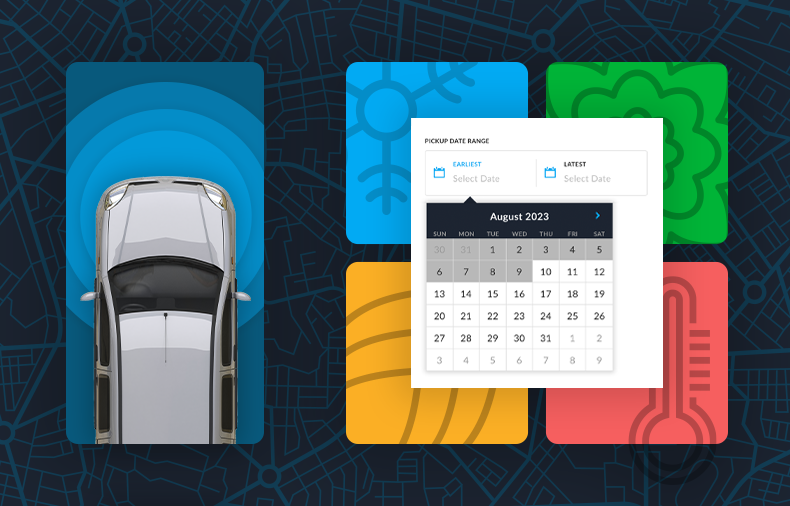When it comes to car shipping, choosing the right time can play a key role in ensuring a smooth and cost-effective experience. As seasons change, different factors can significantly influence the timing and success of transporting vehicles. From fluctuating weather conditions to shifting demand, understanding seasonal dynamics is essential for anyone looking to transport a vehicle efficiently and safely.
In this guide, we’ll cover essential considerations when shipping a car across different seasons. We’ll also provide an overview of the factors that come into play throughout the year, helping you pinpoint the best times for car shipping and how to prepare. Let’s unlock the secrets to successful car shipping throughout the year so you can make informed decisions that save both time and money.
IMPORTANCE OF SEASONAL CAR SHIPPING
Seasonal variations have a significant impact on car shipping services. Weather conditions and demand fluctuations can influence the cost, safety, vehicle protection, and duration of the shipping process. Here are the main implications of shipping a car in different seasons so you can make the best decision for your shipping needs.
SPRING: PROS AND CONS

As winter comes to an end, spring offers opportunities and benefits for shippers. A season marked by its moderate weather, spring is an ideal time to transport vehicles without worrying about the severe damages or delays often associated with harsh winter or summer conditions.
At the same time, spring typically features less congested roads, boosting the ease of shipping while promising quicker transit times and a stress-free experience. By shipping during spring, you can ensure both your vehicle and peace of mind are well-preserved.
Pros
- Moderate Weather: Spring offers a mild climate, which is ideal for shipping vehicles, reducing the risk of weather-related damages or delays.
- Less Traffic: Compared to the summer months, spring often witnesses less traffic, making it relatively easier and quicker to ship your car.
Cons
- Sporadic Rain: Spring showers can be somewhat unpredictable, potentially causing delays in shipping schedules.
- Pollen: The season is synonymous with high pollen count, which might necessitate a thorough car wash upon arrival at the destination.
SUMMER: PROS AND CONS

Summer stands as a beacon of reliability in the car shipping industry. Thanks to its extended daylight hours, it’s possible to achieve longer transportation distances within a single day, which can help accelerate the shipping process considerably. Furthermore, the stability in weather conditions ensures adherence to schedules, reducing the likelihood of unexpected delays and fostering a predictable shipping environment.
Pros
- Longer Daylight Hours: The extended daylight hours in summer ensure your car can be transported over longer distances in a single day, which can help expedite shipping.
- Predictable Schedules: Summer weather is generally stable, making it easier to stick to predetermined shipping schedules.
Cons
- High Demand: As a peak season, summer often sees a surge in demand, which can escalate shipping costs.
- Potential Heat Damage: Extreme temperatures may pose a risk of overheating or paint damage to your vehicle.
FALL: PROS AND CONS

Fall is a season of balance in the car shipping industry. As the demand for services starts tapering off, shippers can look forward to more competitive pricing options. The mild temperatures also create an ideal environment for transporting vehicles, steering clear of the extreme conditions witnessed in summer and winter.
Pros
- Off-Peak Pricing: With demand tapering off, fall offers more competitive pricing options for car shipping.
- Cooler Temperatures: The mild weather conditions in fall can be a major benefit for vehicle transportation, avoiding the extreme temperatures seen in summer and winter.
Cons
- Early Snowfall: In certain regions, fall can bring early snowfall, potentially creating transportation delays and hazards.
- Variable Weather: The transitional nature of fall can sometimes bring unpredictable weather patterns, impacting the shipping schedules.
WINTER: PROS AND CONS

Winter is generally considered the off-peak season for car shipping. With fewer people relocating or shipping vehicles, it’s often easier to find a reliable carrier for your vehicle.
Due to decreased demand, service providers are typically more flexible with scheduling. Lower demand can also lead to lower prices, potentially saving you money on transportation fees.
Pros
- Lower Prices: Winter often sees a dip in demand, which can result in more affordable shipping options.
- Less Demand: With fewer people opting to ship their vehicles, securing a spot for your car on a transporter can be easier.
Cons
- Potential Weather Delays: Harsh winter conditions, such as snowstorms, can cause significant delays in shipping schedules.
- Icy Roads: Transporting a vehicle in winter means navigating icy and sometimes treacherous roads, potentially posing safety risks.
TIPS FOR CAR SHIPPING ACROSS DIFFERENT SEASONS
Regardless of the season, booking your car shipping service in advance can help you secure better rates and ensure availability. Make sure that your vehicle is adequately insured against potential damages during the transportation process, and take the time to remove all personal items from the car to prepare your vehicle for shipping.
SPRING
- Weather Forecast: Keep an eye on the weather forecast to anticipate any delays due to unpredictable spring showers.
- Pollen Protection: Consider opting for enclosed shipping to protect your car from pollen, which is common during the spring season.
SUMMER
- Heat Protection: Protect your vehicle from potential heat damage by checking the fluid levels and ensuring the battery is in good condition before shipping.
- Early Bookings: Since summer is a peak season, consider booking your service early to avoid high costs and ensure availability.
FALL
- Flexible Scheduling: Take advantage of off-peak pricing by being flexible with your shipping dates to secure the best deals.
- Weather Preparations: Prepare for unpredictable weather patterns by ensuring your vehicle is ready to face potential early snowfall or rain.
WINTER
- Anti-freeze: Ensure your vehicle is filled with adequate antifreeze to prevent the engine from freezing in cold conditions.
- Snow Preparation: Equip your car with snow-ready features, such as winter tires, to ensure it’s ready to drive off once it reaches its destination.
Remember: No matter what season you’re shipping in, a well-maintained vehicle and a reliable shipping company are key for a successful car shipping experience. Always conduct thorough research before choosing a shipping service to ensure the safety and timely delivery of your vehicle.
UNDERSTANDING SEASONAL SHIPPING TRENDS
Ultimately, getting the best shipping rates requires a blend of planning, timing, and negotiation. Different seasons present different opportunities and challenges, which can significantly impact the cost of shipping.
Above all else, it’s essential to understand the ebb and flow of demand throughout the year. Typically, the summer months are peak seasons with higher rates, while the winter months might offer lower prices due to decreased demand. Here’s how you can navigate each season:
SPRING
- Early Bookings: Since spring is a popular time for relocation, aim to book your shipment in advance to lock in favorable rates before the peak period hits.
- Flexible Scheduling: If possible, be flexible with your shipping dates to work around potential rainy periods, which might cause delays and increased costs.
SUMMER
- Avoid Peak Periods: Try to avoid shipping your car during the peak summer months of July and August, when demand and prices are at their highest.
- Bulk Shipments: If possible, try to coordinate with others moving in the same direction to take advantage of discounts on bulk shipments.
FALL
- Capitalize on Off-Peak Pricing: With the demand decreasing, fall can be an excellent time to negotiate better rates with shipping companies.
- Weekday Shipments: Since most people prefer to ship over weekends, weekday shipments may provide better rates.
WINTER
- Leverage Low Demand: Utilize the decreased demand to negotiate lower prices with shipping companies.
- Advance Booking: Booking your shipment in advance to help secure better rates, even in the low-demand season.
Once you’re aware of the seasonal trends, use this knowledge to negotiate with carriers. Be sure to request quotes from different service providers—and don’t hesitate to negotiate for better deals.
CHOOSING THE RIGHT CAR SHIPPING OPTION
Depending on the season, choosing the right shipping option—open or enclosed—can also impact your shipping rate. Enclosed transport might be a better option during extreme weather conditions, even though it might be slightly more expensive.
PREPARING YOUR VEHICLE FOR CAR SHIPPING
Proper preparation of your vehicle for the shipment can also help you cut costs. For instance, during winter, ensuring your car is winterized can help prevent potential damage, saving you money in the long run.
At the end of the day, the key to securing the best rates is a combination of understanding seasonal nuances, negotiating, and preparing your vehicle for the specific season it’s being shipped in.
CONCLUSION
Choosing the best time to ship your car demands careful consideration. By understanding the pros and cons that each season holds, you’ll be better equipped to make decisions that are both economical and safe for your vehicle.
Whether you choose to ship during peak season or leverage low demand, ensure the safety of your vehicle and do your research before choosing a shipping company. With uShip, you can easily compare services and rates from multiple carriers to find the most competitive car shipping quotes. Try It Today!
SEASONAL CAR SHIPPING FAQS
How does weather affect car shipping rates?
Weather significantly impacts car shipping rates. Extreme weather conditions can cause delays and increase the demand for enclosed carriers, potentially driving up the prices. Moreover, the prices might rise during the seasons when the demand is high due to favorable conditions.
Is it cheaper to ship a car in winter or summer?
Generally, it’s cheaper to ship a car during the winter due to lower demand, as opposed to the peak summer season. However, this might vary depending on the specific routes and regions given the potential weather-related challenges during winter.
How can I protect my car during transportation in different seasons?
Protecting your car during transportation involves different strategies for different seasons. Choosing enclosed carriers can help shield your vehicle from harsh weather conditions and debris. Moreover, preparing your car by sealing any leaks and removing personal items can further safeguard it during transit, irrespective of the season.
What are the peak seasons for car shipping?
The peak seasons for car shipping are usually summer and early fall, when the weather is stable and many people are relocating or buying cars. During these times, you might encounter higher prices and longer shipping durations due to increased demand.
Are there specific months that offer the best car shipping deals?
Late fall and winter can often offer the best car shipping deals, as demand typically decreases during these periods. You might find more competitive prices and availability during these months.
What precautions are taken by carriers during snowy months?
During snowy months, carriers tend to take extra precautions such as monitoring weather patterns closely to avoid storms, using covered carriers to protect vehicles from snow and ice, and ensuring vehicles are securely fastened to prevent movement during transportation on slippery roads.
Is it safe to ship my car during the hot summer months?
It’s generally safe to ship your car during the hot summer months. However, it’s recommended to prepare your vehicle for the heat by checking the coolant levels and battery. Consider opting for covered transport to protect your car from extreme temperatures and potential paint damage.
How does seasonal demand influence car shipping durations?
Seasonal demand significantly influences car shipping durations. During peak seasons, the high demand might lead to longer shipping times as carriers have more loads to manage. Conversely, during off-peak seasons, you might find quicker shipping durations due to fewer shipments.
Ready to book your shipment? Create your free listing and find competitive car shipping rates today.



